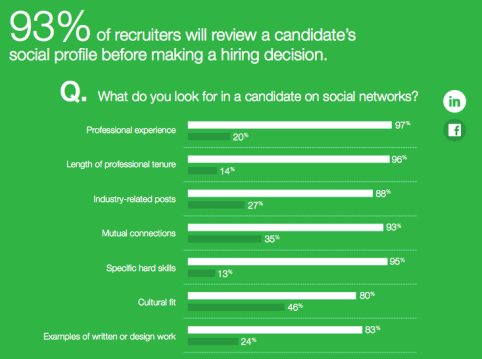Topic 3: Online Professional Profiles – It’s All About the Brand
Unfortunately, our online behaviour is socially and culturally judged – how we are viewed by others is determined by our online conduct (Costa and Torres, 2011). This, along with increasing numbers of employers using the Web to search for employees, has led to sites such as LinkedIn becoming increasingly popular. By expanding you online presence through sites such as LinkedIn, you appear visible, relevant and more attractive to employers.
A recent study conducted by OfficeTeam, found that one third of employers believe that social media profiles will replace CVs in the coming years (Schawbel, 2011). LinkedIn has over 300million users and as a result is the preferred site for developing an authentic professional profile.
- Job email alerts.
- Connecting with professionals – both nationally and internationally.
- Conducting company research.
- Getting recommendations.
- Allowing companies to find you.
- Connecting with other students.
Through LinkedIn you can create a dynamic profile, it acts as more than just a CV as you’re able to upload files and presentations, which showcase your portfolio and individuality.
Jobvite’s 2014 Social Recruiting Survey, found that more than 93% of employers view the social media sites of their employees before recruiting them (Jobvite, 2014). However, they also found that these sites go beyond platforms such as LinkedIn – 52% now use Twitter. Twitter offers users unrestricted access to other members, including possible employers (Le Viet, 2014). By interacting with their posts you will encourage further communication, through this you stay in the forefront of their mind when hiring.
However, when using sites such as LinkedIn and Twitter to develop an authentic professional profile, it is important to be active and relevant. It is all about self-branding. My current LinkedIn status is static – it barely contains any information, as a result I don’t appear particularly relevant or attractive to employers. This video, of the lecture given by Helen Standing at Leeds Metropolitan University, discusses how individuals can successfully build a professional profile.
A Few Tips from the Video:
- Transparency in key.
- Tailor yourself to different audiences.
- Create a niche.
- Use social media as a research tool.
- Keep your finger on the pulse.
- Be sure to maintain your personal brand.
About.Me is a particularly useful site to manage various professional platforms; it acts as an E-Business card or social hub, allowing you to compile information such as a short bio and images, as well as connections to your blog, Facebook, LinkedIn and other profiles. This makes it more efficient for individuals when searching for you, as all of your connections will be in one place. Similarly, the more active you are, on LinkedIn for example, the higher you’ll rank when explored on search engines such as Google. However, with this increased visibility, it is important to remain safe and secure online – only provide necessary personal information and limit the amount of contact information, such as your address and phone number.
References:
Costa, C. and Torres, R. (2011) To Be or Not To Be? The Importance of Digital Identity in the Networked Society, University of Salford, UK.
Jobvite. (2014) Social Recruiting Survey, Accessed: March 2015.
Le Viet, S. (2014) Twitter’s Redesign Makes the Platform Ripe for Recruitment, Accessed: March 2015.
Schawbel, D. (2011) 5 Reasons Why Your Online Presence Will Replace Your Resume in 10 Years, Accessed: March 2015.
Standing, H. (2012) Social Media Personal Branding, Accessed: March 2015.
Undercover Recruiter. (2015) 7 Ways College Students Can Benefit from LinkedIn, Accessed: March 2015.

